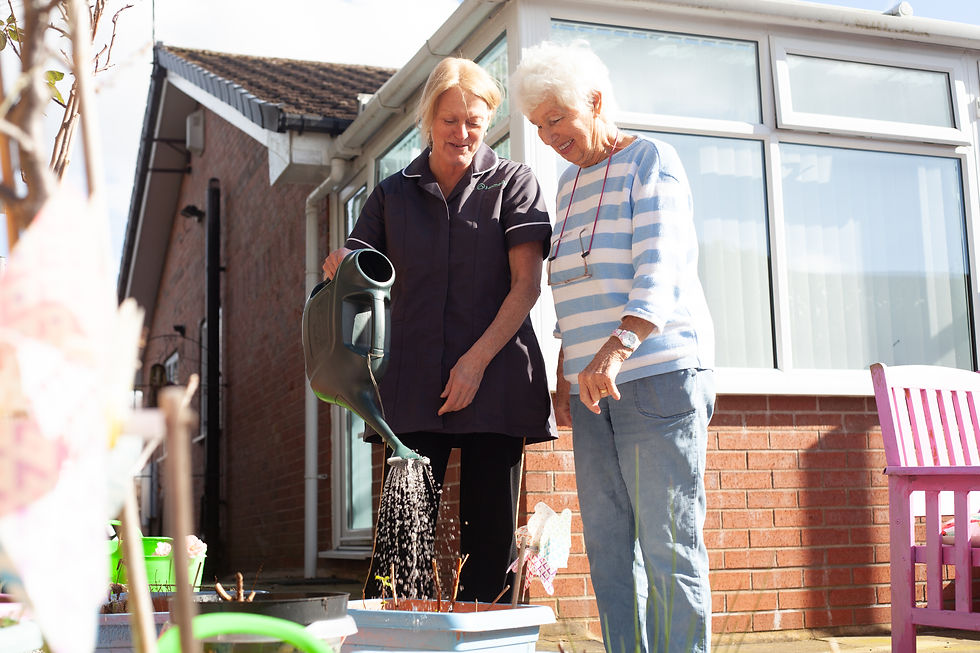How to Get Rid of Swollen Ankles: Practical Advice for Older Adults and Their Families
- Homelium

- Jul 8
- 3 min read

Swollen ankles, medically known as edema, are a common concern for older adults. While swelling can occur for a variety of reasons, including standing or sitting too long, certain medications, or underlying health conditions like heart or kidney problems, it’s not something that should be ignored.
Although occasional swelling isn’t always serious, persistent or worsening edema can be uncomfortable, affect balance, and increase the risk of falls or infections. Fortunately, there are several safe and effective ways to reduce swollen ankles and improve overall comfort and mobility.
1. Gentle Movement and Exercise
Staying active is key to reducing swelling. Movement helps stimulate circulation, preventing blood and fluid from pooling in the lower extremities. Encourage short walks around the home or garden, simple stretches, or seated exercises like ankle rolls and toe lifts. Even just flexing the ankles while seated can help keep blood flowing properly.
For those with limited mobility, a carer can support safe, low-impact activity that promotes circulation without overexertion.
2. Elevate the Legs
Raising the legs above heart level a few times a day allows gravity to assist with drainage. Try using cushions or a footstool while sitting, or lie back and prop the legs on pillows. Just 20–30 minutes a few times daily can help reduce swelling noticeably.
This is especially useful in the evening, when swelling tends to be worse after a full day of being upright.
3. Compression Socks
Wearing compression stockings is a simple and effective way to manage swollen ankles. These specially designed socks apply gentle pressure to the lower legs, improving circulation and helping to move fluid away from the ankles.
They come in various strengths and styles, speak with a pharmacist or GP about the right fit and type. Carers can assist with putting them on daily if it becomes difficult.
4. Stay Hydrated and Reduce Salt
Dehydration and excess salt in the diet can both contribute to fluid retention. Make sure your loved one is drinking enough water during the day and avoiding heavily processed or salty foods. A balanced diet full of fresh fruit, vegetables, and whole foods supports better circulation and reduces inflammation.
Home carers can help with meal preparation and gentle reminders to stay hydrated, especially important in warm weather or for those on certain medications.
5. Check Medications and Underlying Conditions
Some medications, such as blood pressure pills, steroids, or anti-inflammatories, can lead to swelling as a side effect. If swelling becomes sudden or severe, always consult a GP to rule out serious conditions like heart, liver, or kidney issues.
A carer’s regular presence in the home means changes like swelling, fatigue, or reduced mobility can be picked up early and action taken quickly.
6. How Home Care Can Help
At Homelium Care, our trained carers are here to support older adults with day-to-day routines that help manage and reduce swollen ankles. From helping with mobility and leg elevation to meal prep, hydration reminders, or simply being another set of eyes to spot early signs of concern, we’re here to keep your loved ones safe, comfortable, and independent at home.
Regular home care visits mean someone is always there to assist with physical care, encourage healthy habits and communicate concerns to family or medical professionals if needed.
When to Seek Medical Help: If swelling is accompanied by pain, redness, heat, or sudden onset, seek medical advice immediately. These can be signs of a blood clot or other serious condition.
If you're concerned about a loved one’s swollen ankles or need extra support at home, Homelium Care is here to help.
Call us on 0333 3448 677 or email hello@homelium.com to see how we can best support you and your family!



Comments